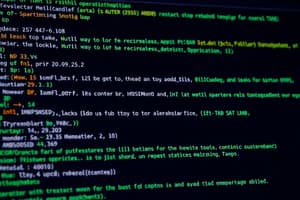Podcast
Questions and Answers
What is the role of the kernel in an operating system?
What is the role of the kernel in an operating system?
Managing low-level hardware interactions and memory management
Explain the function of the shell in an operating system.
Explain the function of the shell in an operating system.
Provides interfaces for users to enter commands and interact with the OS
How does the file system contribute to the core structure of an OS?
How does the file system contribute to the core structure of an OS?
Organizes data storage and provides mechanisms for reading, writing, and retrieval
What is the purpose of device drivers in an operating system?
What is the purpose of device drivers in an operating system?
What role does the Application Programming Interface (API) play in an OS?
What role does the Application Programming Interface (API) play in an OS?
How does Linux differ from macOS in terms of target users?
How does Linux differ from macOS in terms of target users?
What is the main role of an operating system?
What is the main role of an operating system?
How does a single-user operating system differ from a multiple-user operating system?
How does a single-user operating system differ from a multiple-user operating system?
Explain the difference between batch processing and interactive operating systems.
Explain the difference between batch processing and interactive operating systems.
How can you describe an operating system's function using a metaphor?
How can you describe an operating system's function using a metaphor?
What are the two main categories used to classify operating systems based on user access?
What are the two main categories used to classify operating systems based on user access?
In what way do interactive operating systems differ from batch processing operating systems in terms of user interaction?
In what way do interactive operating systems differ from batch processing operating systems in terms of user interaction?
Study Notes
Computer Fundamentals: Operating Systems
Operating systems (OS) form the foundation of modern computing. They act as mediators between computer hardware and software, providing essential services and features that allow us to interact with our devices seamlessly. This guide will delve into OS basics while exploring some key concepts within this vital component of computers.
What is an Operating System?
An operating system is a software program designed to manage hardware resources and provide common services for computer programs by creating a user interface and environment for users to interact with their machines. It's like a conductor directing the symphony of your computer components to produce desired outcomes.
Types of Operating Systems
There are two main categories of operating systems:
-
Single User vs Multiple Users: A single-user OS allows one person at a time to control the machine, whereas multiple-user OSes support simultaneous access for several individuals via accounts.
-
Batch Processing vs Interactive: Batch processing OSes process jobs sequentially without real-time input from users, which means you submit tasks and wait until they complete. In contrast, interactive OSes offer immediate feedback and responsiveness to commands entered through inputs such as a keyboard and mouse.
Additionally, operating systems can also be classified based on their architecture, execution model, and intended purpose (e.g., desktop, server, embedded), among other criteria.
Key Components of an Operating System
The following elements help make up the core structure and functionality of an OS:
- Kernel - An integral part of the OS responsible for managing low-level hardware interactions and memory management.
- Shell - Provides interfaces and environments where users enter commands to interact with the OS and run applications.
- File System - Organizes data storage, provides mechanisms for reading, writing, and retrieval.
- Device Drivers - Mediate communication between the kernel and specific hardware peripherals.
- Application Programming Interface (API) - Allows developers to create software compatible with the OS.
Common Operating Systems
Several popular OSes dominate today's marketplace:
- Windows family – Microsoft Corporation
- macOS – Apple Inc.
- Linux – Open Source Initiative
- iOS – Apple Inc.
- Chrome OS – Google LLC
Each OS has its unique characteristics, strengths, and weaknesses, catering to various user needs. For instance, macOS targets consumers who want to experience a consistent UI across all Apple products, while Linux is favored by many developers due to its open-source nature.
Understanding operating systems forms a cornerstone of fundamental computer knowledge. The more we learn about them, the better equipped we become to navigate and optimize our digital experiences effectively.
Studying That Suits You
Use AI to generate personalized quizzes and flashcards to suit your learning preferences.
Description
Test your knowledge on operating systems, the essential software programs that manage hardware resources and provide common services for computer operations. Explore key concepts such as types of operating systems, key components, and common OSes in today's marketplace.




